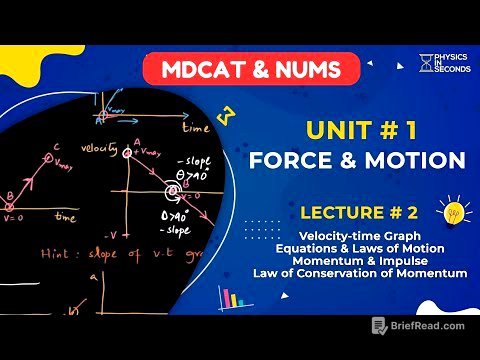TLDR;
This video features Dr. Muzaffer Ecevit discussing the double verse method in the Quran, emphasizing that verses often come in pairs or are explained through parenthetical verses. He illustrates this concept using Surah An-Nur and Surah Al-Fath, highlighting the symmetrical order and hierarchical structure within the verses. The discussion covers forbidden marriages, proper conduct for men and women, and the importance of understanding the Quran's intricate arrangements.
- Verses in the Quran often come in pairs or are explained through parenthetical verses.
- The arrangement of verses reveals a symmetrical order and hierarchical structure.
- Understanding the Quran requires careful examination and appreciation of its depth and subtlety.
Introduction [0:00]
Dr. Muzaffer Ecevit begins by expressing his intention to continue the discussion on the double verse method in the Quran, particularly focusing on Surah Yusuf. However, he decides to first address some points that were missing from the previous lesson. He emphasizes that the verses of the Quran are often presented in pairs or twins, although not always in a straightforward manner.
The Concept of Paired Verses [1:33]
Dr. Ecevit explains that verses in the Quran often come in pairs, with one verse followed by a parenthesis that contains two verses explaining the initial verse. He draws an analogy to the diversity of flowers in nature, noting that God is not limited in His arrangements. He cautions against oversimplifying the concept of paired verses, as the system is vast and deep. Understanding this pairing has a significant impact on exegesis, interpretations, and jurisprudence.
Surah An-Nisa, Verse 23: Forbidden Marriages [5:27]
Dr. Ecevit uses Surah An-Nisa, verse 23, to illustrate the concept of paired verses. The verse lists women whom men are forbidden to marry, starting with the biological mother. He points out the similarity and closeness between daughters and sisters, noting how they are placed in order immediately after the biological mother. The verse continues with aunts, brothers' daughters, and sisters' daughters, showcasing a symmetrical order. He also discusses wet nurses and foster sisters, highlighting the similarities between them.
Symmetry and Hierarchy in Forbidden Marriages [10:35]
Dr. Ecevit continues to explain the forbidden marriages, including wives' mothers (mothers-in-law) and wives' daughters (stepdaughters). He draws parallels between foster mothers and mothers-in-law, noting that neither gave birth but are considered mothers due to breastfeeding or marriage. He also discusses the prohibition of marrying one's daughter-in-law and combining two sisters in the same marriage. He emphasizes the symmetry between one's own daughter and daughter-in-law, as well as between one's own sister and wife's sister.
Mirroring Etiquette for Men and Women [18:08]
Dr. Ecevit addresses the question of whether the verse on forbidden marriages implies a similar declaration for women regarding whom they cannot marry. He explains that the Quran often presents etiquette and manners in a way that reflects in a mirror. The prohibitions for men imply corresponding prohibitions for women, such as a woman not being able to marry her biological father or son. He dismisses the idea that women are not given priority in the Quran, noting that men and women are often mentioned together in verses.
Hierarchical Degrees of Haram [21:34]
Dr. Ecevit explains that the verse on forbidden marriages also indicates a hierarchical order. While all listed marriages are forbidden (haram), the degree of prohibition varies. He uses the analogy of military ranks, with the biological mother being the highest rank (pasha) and other forbidden relations being lower ranks (commanders, company commanders). This hierarchy becomes more apparent when examining other verses.
Surah An-Nur, Verse 31: Conduct for Believing Women [25:10]
Dr. Ecevit transitions to Surah An-Nur, verse 31, which addresses believing women. The verse instructs women to turn their eyes away from men's private parts and to guard their own private parts. He notes that this verse also implies a similar instruction for men, urging them to avoid looking at women's private parts. He emphasizes that the Quran addresses both men and women, giving neither priority.
Adornments and Head Coverings [28:35]
Dr. Ecevit discusses the part of Surah An-Nur, verse 31, that addresses women's adornments. He interprets the verse to mean that women should not expose their breasts, which he identifies as a significant adornment. He explains that women should let their head coverings fall over their collars to cover their chests. He also notes that women should not stamp their feet in a way that reveals their hidden adornments.
Exceptions for Revealing Adornments [34:36]
Dr. Ecevit explains that Surah An-Nur, verse 31, provides exceptions for whom women can reveal their adornments. These exceptions include husbands, fathers, fathers-in-law, sons, stepsons, brothers, brothers' sons, sisters' sons, other women, and slaves. He notes that the level of comfort and permissibility varies among these groups, with husbands having the highest level of permissibility.
Hierarchical Degrees of Revealing Adornments [38:26]
Dr. Ecevit summarizes the hierarchical structure within Surah An-Nur, verse 31. The verse progresses from the most secret place (private parts) to the hiding of adornments, to whom the adornments can be revealed, and finally, with whom they can be revealed with more caution. He emphasizes that the verse moves inward, step by step, with each level requiring more care and discretion.
Surah Al-Fath, Verse 9: Parenthetical Structure [39:57]
Dr. Ecevit introduces Surah Al-Fath, verse 9, as another example of the parenthetical structure in the Quran. He explains that the verse instructs believers to believe in Allah and His Messenger, support the Prophet, and glorify Allah morning and evening. He points out that the instruction to believe in Allah and His Messenger is in parentheses, indicating a connection between the two.
Conclusion: Importance of Parenthetical Structure [45:00]
Dr. Ecevit concludes by emphasizing the importance of recognizing the parenthetical structure in the Quran. He notes that this structure appears throughout the Quran, with opening and closing parentheses indicating the relationship between different topics. He reiterates that the outer subject is always bigger, and the topics inside are one level lower, step by step.









